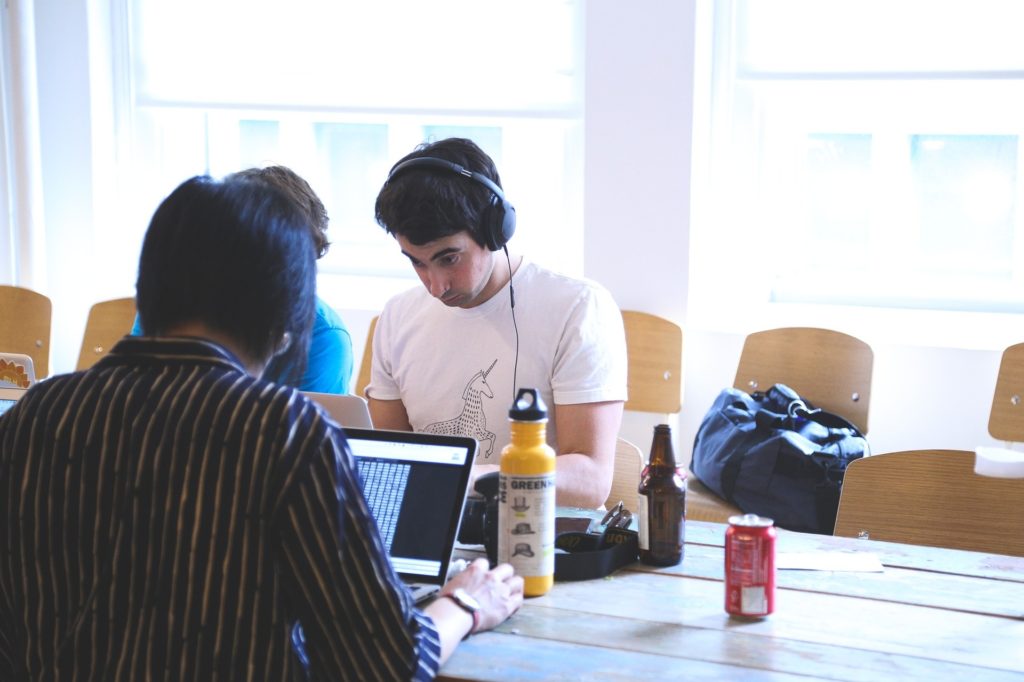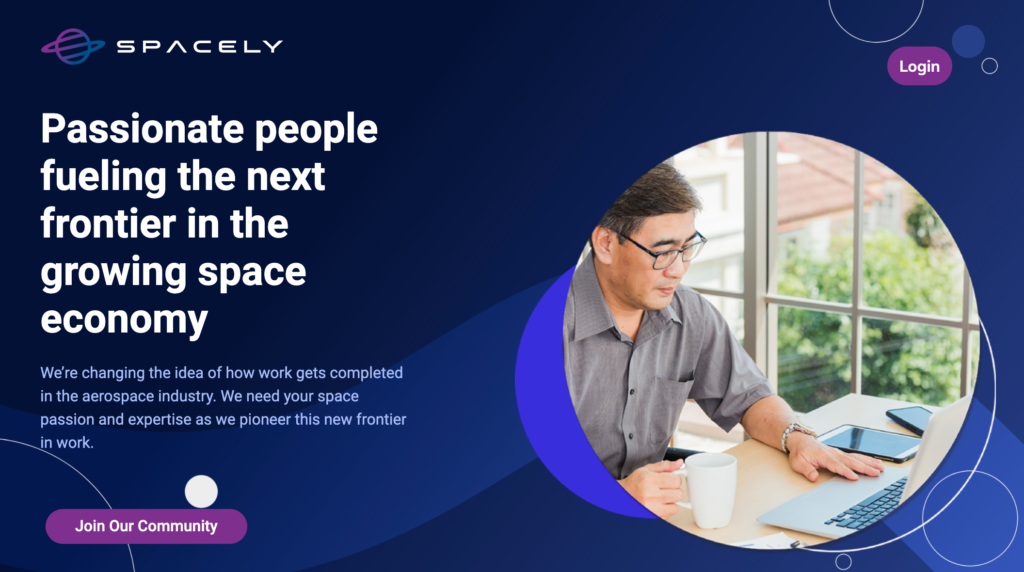Note from Brett: This is a special and exclusive guest post from Tom Cooke, co-Founder and CEO of Spacely. Two of the major take-aways I want people to understand and appreciate from my book “How To Be a Rocket Scientist” (and by extension this website) is that an entrepreneurial mindset is essential in today’s world. Second, more opportunities exist now than ever before for people to enter the aerospace field – no matter who or where you are. Spacely is a perfect – and exciting – example of these truths. Resolve to understand the changes in our world and take advantage of them. It is my honor and thrill to present Tom Cooke who will tell you more about these trends, then how and why Spacely is an ingenious solution for multiple problems in the space community. — Brett
BIG CHANGES ON THE MENU
With the arrival of the platform economy – enabled by technological advances in computing power, machine learning and artificial intelligence – it is now possible for someone to have a split second thought about one of their favorite meals and after quickly checking several platforms for the best cost and earliest delivery time, make the snap decision and begin enjoying their favorite lunch, measured in minutes later. All while never leaving the confines of their home.
To some, never leaving the house and eating all day doesn’t sound appealing. But the focus of this article are the enabling technologies and expectations behind this new economy, not whether you should or shouldn’t stay in your pajamas all day.
To continue with this food analogy, the early days of fast food supported wage workers who were on their lunch break and wanted a warm meal. It nourished those who wanted a break from microwaving dinners that sat on TV trays. And it served Americans who became more mobile thanks to the automobile and new freeways crisscrossing the country.

Today the fast food industry market value is around $650 Billion and is expected to approach nearly $1 Trillion by the end of this decade. One of the main factors supporting this anticipated growth is the advances in ordering technology. If you make it easier to access your product, greater opportunity from larger markets emerge. No longer is a restaurant stymied by the idle, potential customer who doesn’t want to leave the house to place their order. Now they can advertise directly to that person and deliver the goods all by using technology that removes the pesky friction of making that person come to them. They meet the customer where they are, not the other way around.
So, what does all this food talk have to do with aerospace – other than both industries being estimated to have similar market sizes this coming decade?
Everything.
INNOVATE OR SAY GOODBYE
It is no longer sufficient to set up shop and wait for business to come in. Businesses must now anticipate what the consumer wants before they know they want it and cater to these behaviors. That’s what their competitors are doing. Most importantly, that in turn drives consumer expectations.
Are there any business or consumer expectations that you’ve seen shift in the past year during the pandemic? You bet.
Expectations shift all the time for a variety of reasons. Sometimes trends go out of style only to come back years later. Sometimes we’re convinced, like with the smartphone, that we cannot live and function in modern society without a new product or service.
It is only time that helps us navigate to the “ground truth.” As we know, expectations for our interactions in everyday life flows into how we gather, how we socialize, and how we work.
Those expectations continually shift.
SHIFTING EXPECTATIONS ARE DRVING SEISMIC WORKFORCE CHANGES
My grandfather worked for AT&T for 30 years. He had a good paycheck, was able to buy a modest middle-class house, and raise a family. It was a pretty good life that was supported also by the pension he received from the company upon his retirement until he passed away.
I had a pretty good example in front of me of what model to follow, but I did not choose to work for AT&T for 30 years. I had different expectations.
And if you look at today’s workforce it is clear they have different expectations as well. The average American adult stays in a job no longer than four years. The average Millennial has an even shorter span of 18 months.
It’s not because they are a lazy generation. It is because their expectations have changed. Not one Millennial or Gen Z’er I’ve spoken with has said they can see themselves working for one company for the next 30 years.
Breaking point moments like the Dot Com bubble, 9/11, the 2008 financial collapse, greater corporate consolidation and globalization, and the recent pandemic are emblematic of seismic shifts in their life.
They are not betting on solid footing or a sure thing.

The expectations for how I live in today’s society have shifted dramatically over the past 20 years, mostly in the way I personally interact with my surroundings.
The rise of choices that support individualism means you no longer have to hunt in groups for food. You no longer need to own a house or a car to meet basic needs. Technology even supports living in artificial realities we call virtual or augmented specific to our own perspective.
These trends in increasing independence permeate society and are showing up in the way we work.
A full third of the U.S. workforce considers themselves independent. This percentage is expected to grow to half of the workforce by 2030. Half of this population is over 55 years old. Most of them have already retired from their primary career. These people work because they want to work on something they enjoy, not because of financial necessity.
This expectation to enjoy work is growing in the younger generations as well. The rise of the “passion economy” resembles the changing social contract through serious efforts to redefine rights and duties of the ruled and their rulers, the workers and their employers.
MAJOR IMPACTS TO CORPORATIONS
The younger generations question the validity of capitalism and seek social change by throwing their weight and support behind holding corporations accountable and responsible beyond the company bottom line and the paycheck they receive.
Investors have taken notice of this shift in expectations and now account for the non-financial factors of Environmental, Social, and Corporate Governance (ESG) as they assess risk and growth opportunities for their portfolios.
The new generation questions the balance in companies who use – or to some, exploit – workers’ talents in order to enrich corporate executives and their shareholders while executives make 287 times the average employee.
No, the new generations do not feel loyalty to companies the same way as I did or my grandfather did. Their expectations have shifted and presume a different balance in what companies are meant to provide to society, to workers, and in how their lives are ultimately structured.
Accelerated by the pandemic and the work from anywhere (WFA) movement, the phrase going around now is “integrating work into my life, not the other way around.”

The companies and industries that take notice of these shifting expectations stand to fare much better than those stuck in industrial age thinking. Thinking that everyone wants a good paying union job that makes sure you have “safe and secure” full time employment for the rest of your adult life is not what this generation is thinking. They look at unions as unnecessary intermediaries that further extract value from their talents while they might get a percentage raise to keep up with inflation. They see technology as the new intermediary that is much lower cost, that allows greater individual agency, and that allows them greater mobility with no strings attached.
Remember when Tesla fought against having car dealerships as intermediaries? Or remember when you started using Expedia instead of calling the travel agent?
THE “WAR ON TALENT” HAS MANY FRONTS – AND DIVERSE WARRIORS
The platform economy and enabling technologies are providing tools to order a sandwich when you want, borrow a car when you want, work from where you want, and can effectively help people live how they want.
Millenials – and open-minded professionals of every generation – have more tools and resources available to them than my grandfather could have ever imagined. This is exactly why the aerospace industry should be part of the gig economy.
The companies and their investors who are following these shifting expectations are opening up new pathways to access this group of talent. This talent pool could include the following:
- the retired person who has built up corporate expertise but wants to live at the beach and is done with the 9-5 routine.
- the mom who has an Ivy League MBA and wants temporary balance in providing her skills and talents to be a mom while simultaneously being engaged in meaningful work.
- the neurodiverse person who struggles to work through barriers to inclusion or access to enjoy work on their terms.
- the person who loves their company but has to move back to a remote geographic location to take care of a loved one who is ill.
- it certainly can include the talented youngster who older people scoff at when hearing how they’ll work on a project while they’re living in Costa Rica, but only after they catch the first set of waves.
The companies that make this an either-or decision risk losing talent to the companies and industries where there are multiple pathways to participate in work. Not increasing the numbers of pathways hinders our aerospace industry’s ability to grow, to be agile, to be resilient and – most importantly – our ability to encourage and recruit talented people with shifting expectations to interact with our industry.

INTRODUCING SPACELY – BRINGING THE GIG ECONOMY TO THE AEROSPACE WORLD
We created Spacely in an attempt to open up additional pathways to work in the aerospace industry. We see the trends and shifting expectations. We believe the data behind the incredible growth that open talent platforms are providing to the financial services industry, software development, and other impactful, meaningful areas of work.
No, gig work is not just Uber or Lyft or Instacart or TaskRabbit. The independent professionals in the United States contribute over $1.3 Trillion to the U.S. economy. This is roughly the size of Spain’s Gross Domestic Product (GDP).
If you visit spacetalent.org you’ll see over 500 companies advertising over 11,000 jobs on a traditional job board similar to Indeed or Monster. These openings exist while there are currently over 10 million unemployed Americans. Most opportunities pay well, have benefits, and are in what I like to think is a very compelling industry.
See a problem?
The rise of the independent worker supported by technology, enabled with tools and resources we didn’t have at our fingertips 20-30 years ago, means that we cannot just sit back and do nothing and hope all those jobs suddenly fill. Our nation’s economic vitality and competitiveness depends on optimizing for current conditions and expectations, not those of the past.
The U.S. aerospace industry is seen as the global leader. That has been accomplished by accommodating only those who want to work primarily in Washington State, California, Texas, and Florida. If we are truly concerned with other countries catching up, we need to be thinking about more ways to tap into the full capacity of America, the fierce growing independence of the workforce, and providing as many pathways as possible to participate in our great industry.
Whether you are an aerospace worker who wants new opportunities to apply your unique talent or an aerospace leader who is looking for the best and brightest talent, Spacely aims to be your new home to bring the benefits of the gig economy to you. I hope to see you there at Spacely.work.

Tom Cooke is the Co-founder and CEO of Spacely, an open talent platform supporting the aerospace industry. Spacely’s mission is to increase participation in the industry by creating a multi-sided marketplace for project-based work, community discovery and collaboration, and increasing corporate agility and resilience in a highly competitive and regulated environment. More information can be found at www.spacely.work.
